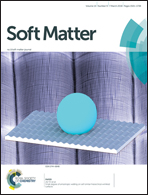Small degree of anisotropic wetting on self-similar hierarchical wrinkled surfaces†
Abstract
We studied the wetting behavior of multiscale self-similar hierarchical wrinkled surfaces. The hierarchical surface was fabricated on poly(dimethylsiloxane) (PDMS) substrates by manipulating the sequential strain release and combined plasma/ultraviolet ozone (UVO) treatment. The generated structured surface shows an independently controlled dual-scale roughness with level-1 small-wavelength wrinkles (wavelength of 700–1500 nm and amplitude of 50–500 nm) resting on level-2 large-wavelength wrinkles (wavelength of 15–35 μm and amplitude of 3.5–5 μm), as well as accompanying orthogonal cracks. By tuning the aspect ratio of hierarchical wrinkles, the degree of wetting anisotropy in hierarchical wrinkled surfaces, defined as the contact angle difference between the parallel and perpendicular directions to the wrinkle grooves, is found to change between 3° and 9°. Through both experimental characterization (confocal fluorescence imaging) and theoretical analyses, we showed that the wetting state in the hierarchical wrinkled surface is in the Wenzel wetting state. We found that the measured apparent contact angle is larger than the theoretically predicted Wenzel contact angle, which is found to be attributed to the three-phase contact line pinning effect of both wrinkles and cracks that generates energetic barriers during the contact line motion. This is evidenced by the observed sudden drop of over 20° in the static contact angles along both perpendicular and parallel directions after slight vibration perturbation. Finally, we concluded that the observed small degree of wetting anisotropy in the hierarchical wrinkled surfaces mainly arises from the competition between orthogonal wrinkles and cracks in the contact line pinning.



 Please wait while we load your content...
Please wait while we load your content...